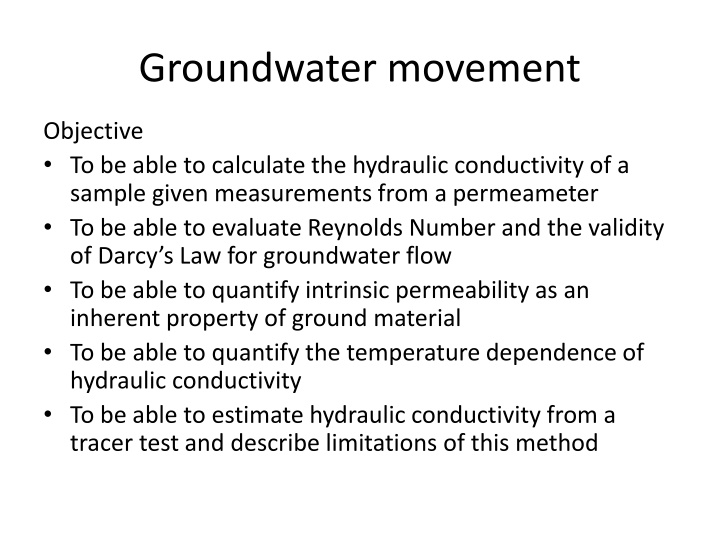
Hydraulic Conductivity and Groundwater Flow Analysis
Learn how to calculate hydraulic conductivity from permeameter measurements, evaluate Darcy's Law, quantify permeability, assess temperature dependence, estimate conductivity from tracer tests, and explore limitations. Practical examples and illustrations included.
Download Presentation

Please find below an Image/Link to download the presentation.
The content on the website is provided AS IS for your information and personal use only. It may not be sold, licensed, or shared on other websites without obtaining consent from the author. If you encounter any issues during the download, it is possible that the publisher has removed the file from their server.
You are allowed to download the files provided on this website for personal or commercial use, subject to the condition that they are used lawfully. All files are the property of their respective owners.
The content on the website is provided AS IS for your information and personal use only. It may not be sold, licensed, or shared on other websites without obtaining consent from the author.
E N D
Presentation Transcript
Groundwater movement Objective To be able to calculate the hydraulic conductivity of a sample given measurements from a permeameter To be able to evaluate Reynolds Number and the validity of Darcy s Law for groundwater flow To be able to quantify intrinsic permeability as an inherent property of ground material To be able to quantify the temperature dependence of hydraulic conductivity To be able to estimate hydraulic conductivity from a tracer test and describe limitations of this method
The figure shows a sample from an unconfined aquifer. L=50 cm, Diameter = 6 cm. The sample is tested for 3 min under constant head difference of 16.3 cm. 45.2 cm3 of water is collected at the outlet. Determine the hydraulic conductivity of the sample Determine the average interstitial velocity assuming a porosity of 0.3 Determine the Reynolds number assuming an effective grain size (d10) of 0.037 cm From Mays, 2011, Ground and Surface Water Hydrology
Water Viscosity at different temperatures From http://www.engineeringtoolbox.com/water-dynamic-kinematic-viscosity-d_596.html
Intrinsic Permeability Parallel conduit conceptual model for porous media flow. vi A Ai 2 i d dh = v i 32 dl v A 32 2 i d 1 dh i i = = q A i medium property k A A dl 2 i 1 d 1 = = = 2 i K A A d / 32 k i i A 32 A
Range of values of Hydraulic Conductivity From Mays, 2011, Ground and Surface Water Hydrology
Constant Head Permeameter ? = ??? ?? ?? ?? ? = From Mays, 2011, Ground and Surface Water Hydrology
Falling Head Permeameter A 20-cm long sample of silty fine sand with diameter of 10 cm is tested. The falling head tube has a diameter of 3 cm and the initial head is 8 cm. Over a period of 8 hr, the head in the tube falls to 1 cm. Estimate the hydraulic conductivity. From Mays, 2011, Ground and Surface Water Hydrology
Tracer Test The water level in two observation wells 20 m apart are 18.4 and 17.1 m. The tracer injected in the first well arrives at the second observation well in 167 hr. Compute the hydraulic conductivity given that the porosity is 0.25 From Mays, 2011, Ground and Surface Water Hydrology
